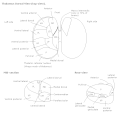| Ventral posterior nucleus | |
|---|---|
 Thalamic nuclei: MNG = Midline nuclear group AN = Anterior nuclear group MD = Medial dorsal nucleus VNG = Ventral nuclear group VA = Ventral anterior nucleus VL = Ventral lateral nucleus VPL = Ventral posterolateral nucleus VPM = Ventral posteromedial nucleus LNG = Lateral nuclear group PUL = Pulvinar MTh = Metathalamus LG = Lateral geniculate nucleus MG = Medial geniculate nucleus | |
 Thalamic nuclei | |
| Details | |
| Part of | Thalamus |
| Identifiers | |
| Latin | Nucleus ventralis posterior |
| NeuroNames | 343 |
| NeuroLex ID | birnlex_1116 |
| Anatomical terms of neuroanatomy | |
The ventral posterior nucleus is the somatosensory relay nucleus in thalamus of the brain. [1]

